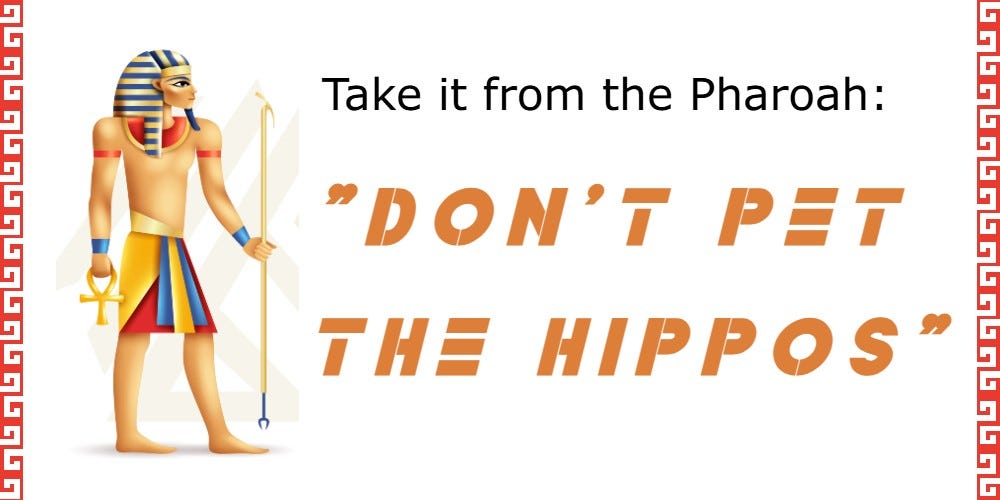He’s one of the world’s largest animals but doesn’t have an ounce of fat on him. He’s a water dweller, but he can’t swim. He weighs a ton and a half but can run up to 20 miles per hour on land. And even though he’s a ferocious man-killer, we make countless children’s toys and cartoons about him. (Maybe we’re the contradictory ones.)
Behold the incredible hippopotamus. His name comes from two words in Greek meaning “horse of the river” (hippo/potamos), literally. Here are a few facts about this amazing animal.
He’s a hybrid water-land creature.
That point about the hippo dwelling in water is both fascinating and biologically necessary. He’s essentially hairless, so his voluminous expanse of skin, which is always exposed to the sun, would get awfully sunburnt in a short time if he weren’t frolicking around in water and mud all day. (Oh, he loves mud.)
There is an African legend that when God created the hippo, He was worried that this monster animal would eat up all the fish in the sea. So, fearing banishment from the water, the hippo negotiated with God and got Him to agree that he could stay in the water most of the day as long as he remained in the shallows. But for food, he had to go up on land and eat grass!
So, the hippo is both a land and a water creature, a vegetarian, and no threat to the fish. That’s what you call a win-win deal for both sides.
In fact, it seems like the fish are sometimes great friends of the hippos. They clean his skin of parasites, and sometimes he opens his mouth underwater and lets them swim in. There, they act like little dental hygienists to keep his huge mouth clean and free of harmful bacteria. Another win-win deal, right?
And speaking of mouths, try opening yours 180 degrees like the hippo. He’s not yawning, though. He does that to scare away rival hippos and other random things he doesn’t like. Since he doesn’t have any natural predators—who would dare?—it seems like he’s always inventing reasons to flaunt his tusks. (He’s a bit of a showman too.)
Amazingly, he can’t swim.
Despite his spending most of the day in water, it’s absolutely true that he can’t swim. I guess if I weighed 3000 pounds, I wouldn’t be able to swim either.
He stays in the shallow water on coasts and marshes, but when he has to navigate deeper water, he moves his huge bulk by sinking down to the bottom and then pushing himself up so that he looks like he is bouncing through the water. Pretty neat!
He glows red.
There’s also an amazing biological fact about his skin. Hippos secrete a red substance called hipposudoric acid which often gives their normally brown skin a vaguely reddish or purplish hue. There’s a practical side to it: the secretion acts as a sort of natural sunscreen for the hippo’s skin.
On the matter of skin, the hippo is the very definition of thick-skinned. Across his huge body, the skin remains almost two-and-a-half inches thick. In street terms, you just can’t insult the guy, not that it would even be wise to try.
Humans beware.
Red, the most common warning sign, may be a good color for anyone on safari to pay attention to when it comes to hippos. Apparently, they don’t like humans very much (which I can fully understand) and will aggressively attack anyone who gets too near them or their companions, especially mother hippos with babies in tow.
In 2014, a hippo capsized a boat on a river in Niger, killing 13 of the 18 occupants. Incredibly, hippos are responsible for about 500 human deaths per year. There’s also a story about an ancient Egyptian Pharaoh named Menes, who we know little about except that he was carried off and eaten by a hippo around 3000 BC.
In other words, the hippos we see in captivity give us a false sense of safety. Rule of thumb: don’t pet the hippos, even in the zoo.
Hippo babies are adorable.
Having said that, I think we can all agree that hippo babies are simply the cutest things on earth, even though they will grow up to be among the homeliest creatures alive. More contradictions!
The gestation period for a hippo lasts for eight months, and at birth, babies weigh over 100 lbs. Females can give birth on land or in the water.
Their moms and dads can hold their breath for about six minutes, but babies have to surface every two or three minutes to take a breath. They are also massively uncoordinated until they grow into their huge bodies, and that’s one of the things that makes them so darn cute.
About ten years ago, the Cincinnati Zoo created a hippo section at the cost of millions of dollars, but I guess their investment paid off soon after that when little Fiona was born (see the short videos at the end.) Baby Fiona alone draws thousands of visitors to the zoo!
[She even has her own web page, “Fiona the World-Famous Hippo”!]
He is the biblical Behemoth.
It’s generally accepted that the biblical creature called the “behemoth” was the hippo. Behemoth is the land beast almost always paired with Leviathan, the biblical sea monster who is thought to be the crocodile. The clearest reference to Behemoth is in the Book of Job:
“Look at Behemoth, which I made just as I made you, it eats grass like an ox. Its strength is in its loins, and its power in the muscles of its belly (Job 40:15-16).”
In a sense, the biblical account reaffirms what humans know by experience about hippos—you don’t mess with them!
Maybe that’s also part of God’s message in creating them. They remind us that there are forces of nature and super-nature (malevolent angels) that inhabit certain realms in this world, and we are best advised to avoid them at all cost.
A message about the Church.
At the same time, we can learn a little from these massive creatures about redemption. In 1927, the poet T.S. Eliot converted to Anglicanism (what he called Anglo-Catholicism) after which he wrote a famous poem about the solidity of a hippo that was no match for the strength of a Church founded on the rock of Peter. The first two stanzas of his poem put the matter like this:
The broad-backed hippopotamus Rests on his belly in the mud; Although he seems so firm to us He is merely flesh and blood. Flesh-and-blood is weak and frail, Susceptible to nervous shock; While the True Church can never fail For it is based upon a rock.
Oceans of ink have been spilled over the interpretation of Eliot’s nine-stanza poem, but the standard way of seeing it is through the eyes of faith.
The contrast between hippo and Church is categorical: the hippo, as powerful as he may be, is a natural powerhouse that lasts only a lifetime. The Church is a spiritual powerhouse that is eternal yet must walk the sorrowful way through the mud of this earth trying to save souls until the end of time.
In the poem, when the hippo dies and happily finds himself in heaven surrounded by angels and saints, he is washed of all his mud by “The Blood of the Lamb.”
“While the True Church remains below,” says Eliot, “Wrapt in the old miasmal mist.”
Sweet dreams for baby hippo Fiona! (20 seconds)
Premature Baby Hippo Fiona Loves the Water (2:14)
-----
Photo Credits: Feature Photo: © Will Burrard-Lucas | Dreamstime.com; Open mouth (Bernard Gagnon); Baby resting on mother (Frank Wouters); Pharaoh image (macrovector on Freepik); Head and eyes (Bernard DUPONT).










Indeed he's very contradictory. Heavy in weight but very light in swimming. Beautiful to look at the color and its skin but so dangerous and animal.
I was at my dentist the other day. I could hardly open my mouth like the hippo. Thanks for sharing.
I'm grateful for your feedback, Lois! We share a love of nature and the good things God has created all around us. And thanks for the subscribe. Hope to keep the quality high for you. Peace, PD